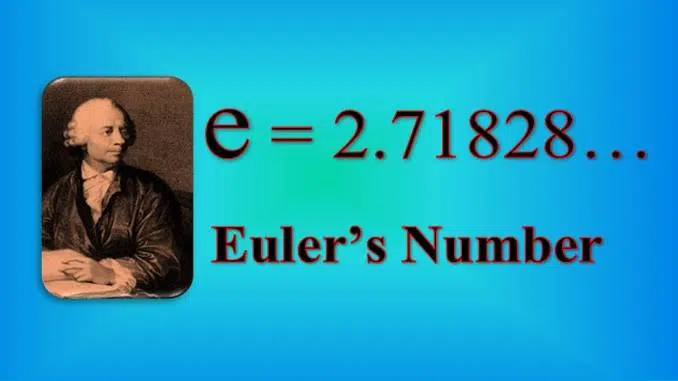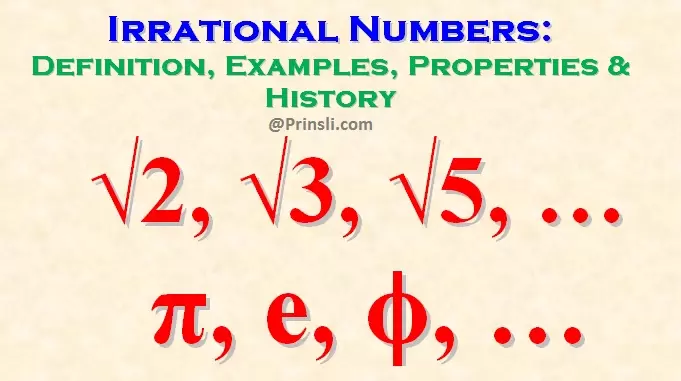
Introduction & History of the Euler’s number ‘e’:
In this article, we will go over the introduction, definition, applications, and history of Euler number e.
What is Euler’s number e: The number e is a mathematical constant approximately equal to 2.718281828459. The value of e is,
2.71828182845904523536028747135266249775724709369995…,
to 50 decimal places.
The sum of the infinite series can also be used to calculate the number e. That is,
After the Swiss mathematician Leonhard Euler (pronounced “Oiler“), it is often called Euler’s number e. Sometimes, it is also known as the Euler constant or Napier constant. However, it is said that Euler’s choice of the symbol ‘e‘ was kept in his honour.
The number e is the base of the natural logarithm (invented by John Napier). The constant was first mentioned in 1618 in a table in an appendix to John Napier‘s work on logarithms.
However, this only contained a list of logarithms calculated from the constant, not the constant itself. The table is thought to have been created by William Oughtred.
When e is used as the base for a logarithm, the corresponding logarithm is called the natural logarithm and is generally written as ln (x), loge(x).
The constant e was discovered by the Swiss mathematician Jacob Bernoulli in 1683, who attempted to find the value of the following expression (which is equal to e) while studying compound interest:
Hence, e is the limit of (1 + 1/n)n as n tends to infinity, an expression that arises in compound interest theory.
The number e is an irrational number (because it cannot be written as a simple fraction) and transcendental (because it is not a root of any non-zero polynomial with rational coefficients).
The number e is very important in mathematics, alongside 0, 1, π, and i. All five of these numbers play important and recurring roles across mathematics, and these five constants appear in one formulation of Euler’s identity, which amazingly states that,
The number e is so special.
The function ex has the remarkable property that the derivative does not change it, so at every point on its graph, the value of ex is also the slope of ex at that point.
History of the Euler’s number ‘e’:
The brief history of Euler’s number e is given below:
- In the year 1618, the number e first appeared in mathematics in a table in which the natural logarithms of various numbers were given in an appendix to Napier‘s work on logarithms.
However, these were logarithms to base e, this went unnoticed because the base on which the logarithm is calculated did not arise in the way that logarithms were thought of at this time. This table in the appendix, although no author is named, was almost surely written by Oughtred.
- In the year 1624, a few years later, Briggs‘ work included a numerical approximation to the base 10 logarithm of e, but there was no mention of e.
- In the year 1647, Saint-Vincent calculated the area under a rectangular hyperbola, but it is still a matter of debate whether he considered the relationship with the logarithm or came across the number e.
- In the year 1661, Huygens examined explicitly the relation between the area under the rectangular hyperbola yx = 1 and the logarithm. Obviously, the value of e is such that, the area under the rectangular hyperbola from 1 to e is 1. Huygens made another advance in 1661. He defined a “logarithmic” curve, but we would call it an exponential curve, with the form y = kax. Again, the logarithm to base 10 of e is derived from this, which Huygens computed to 17 decimal places.
- In the year 1668, the series expansion of log(1+x) was published by Nicolaus Mercator in “Logarithmotechnia”. For the first time, Mercator uses the term “natural logarithm” for logarithms to base e in this work.
The number e does not appear as such once more and remains enigmatically just around the corner once more.
Surprisingly, since this work on logarithms came so close to recognizing the number e when it was first “discovered”, it was through the study of compound interest rather than the notion of logarithms.
- In the year 1683, Jacob Bernoulli investigated the problem of compound interest and attempted to find the limit of (1+1/n)n as n approaches infinity by examining continuous compound interest.
He proved that the limit had to be between 2 and 3 by using the binomial theorem. Jacob Bernoulli may have been the first to recognize that the log function is the inverse of the exponential function.
- In the year 1684, James Gregory certainly recognized the connection between logarithms and exponents, but he may not have been the first.
- According to our knowledge, the first appearance of the number e in its own right is in the year 1690. Leibniz wrote a letter to Huygens in which he used the notation b for what is now known as e.
- In the year 1697, Johann Bernoulli started to study the calculus of exponential functions, publishing “Principia calculi exponentialium seu percurrentium”.
The work involves the calculation of various exponential series and many results are achieved with term by term integration.
Most of our mathematical notations are due to Euler, so it’s no surprise that the symbol ‘e‘ for this number is named after him.
However, it has been claimed sometimes that, Euler chose the letter “e” as it was the first letter of his name. It is unlikely that the word “e“ is derived from “exponential”, but it may have been the next vowel after “a” and Euler was already using the “a” notation in his work.
- In the year 1731, whatever the reason, the notation e made its first appearance in a letter Euler wrote to Goldbach.
- He made several discoveries about e in later years, but it was not until the year 1748 when Euler published “Introductio in Analysin infinitorum” that he addressed all of the issues surrounding e. He showed that,
and that e is the limit of (1+1/n)n as n tends to infinity. Euler gave an approximation for e to 18 decimal places, e = 2.718281828459045235 without explaining where he got this figure.
- The connection between the sine and cosine functions and the complex exponential function, which Euler deduced using De Moivre‘s formula, is one of this work’s most interesting results. Euler, interestingly, also gave the continued fraction expansion of e and mentioned a pattern in the expansion.
- In the year 1854, Shanks was the first to give a large number of decimal places to ‘e‘. Glaisher showed that the first 137 places of Shanks calculations for e were correct but found an error which, after correction by Shanks, gave e to 205 places.
- In the year 1864, Benjamin Peirce took a picture of himself standing in front of a blackboard on which he had written the formula:
- Most people believe that Euler was the first to prove that e is irrational.
- In the year 1873, Hermite has proved that e is not an algebraic number.
- In the year 1884, Boorman computed e to 346 places and observed that his calculation agreed with Shanks up to place 187, but then differed.
- In the year 1887, Adams computed the logarithm of e to the base 10 to 272 places.
Applications of ‘e’ in the Real World:
Euler’s number, e, has many real-life applications.
1. It appears often in growth problems, such as population models.
As for growth questions, think about going to a bank with one dollar, one pound, or whatever currency you have.
2. The base rate of growth shared by all continuously growing processes is represented by the number e.
When all the changes occur at the end of the year, the number e allows you to take a simple growth rate and calculate the impact of compound, continuous growth, where you grow a little bit every nanosecond (or faster). This number e appears whenever systems grow in an exponential and continuous manner, such as interest calculations, radioactive decay, population, and so on.
3. Even jagged systems that do not grow smoothly can be approximated by e.
4. The number e represents the concept that all continuously growing systems are scaled versions of a common rate.
Just as, every number can be thought of as a scaled version of 1 (the base unit), every circle as a scaled version of the unit circle (radius 1), and every rate of growth as a scaled version of e. (unit growth, perfectly compounded). As a result, e is not an obscure (unclear), seemly random number.)
5. In calculus, which is all about finding slopes and areas, you can imagine that e is a pretty important number.
6. It is also an important number in physics.
Here it shows up in the equations for waves, such as light waves, sound waves, and quantum waves.
(स्रोत – फीचर्स)
Read Also: history of number zero (0)
Read Also: history of number Pi (π),
Tags: what is euler’s number, euler’s number e, euler constant value, history of the number e, euler e, euler’s constant e, history of euler’s number, euler’s number compound interest, euler’s number value, history of euler number e
Copyrighted Material © 2019 - 2024 Prinsli.com - All rights reserved
All content on this website is copyrighted. It is prohibited to copy, publish or distribute the content and images of this website through any website, book, newspaper, software, videos, YouTube Channel or any other medium without written permission. You are not authorized to alter, obscure or remove any proprietary information, copyright or logo from this Website in any way. If any of these rules are violated, it will be strongly protested and legal action will be taken.






Be the first to comment